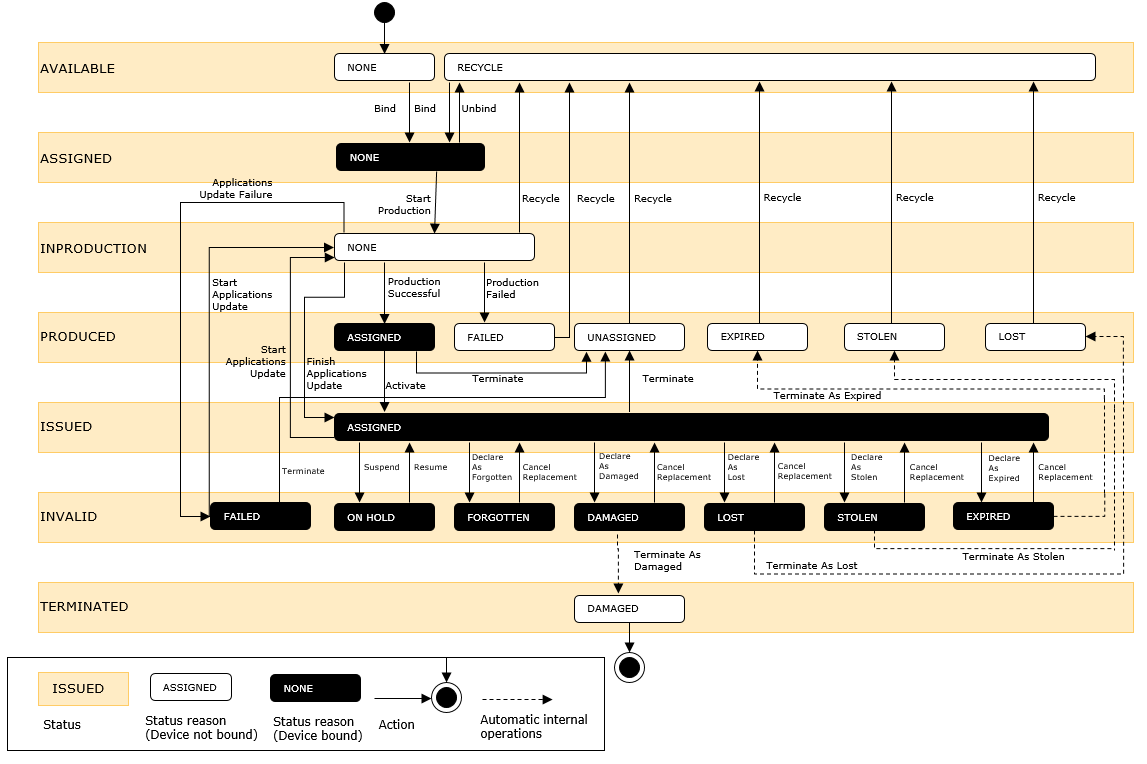About Device Lifecycle Management
In ActivID CMS, a device follows a defined lifecycle which corresponds to different states, starting when an operator receives a new blank device from the manufacturer to the moment when the device is terminated.
From the Operator Portal, you can view the state in which a given device resides by going to the Help Desk page. In the Device Information tab, read the Status column. Also, you can perform a device query, and when the Device Query Details page appears, read the Physical Status line. For more information on how to perform a device query, see Running a Device Query.
There are seven physical states:
-
Available,
-
Assigned,
-
In Production,
-
Produced,
-
Issued,
-
Invalid, and
-
Terminated.
Some of the states result from actions taken by ActivID CMS operators in the Operator Portal (for example, device issuance or device termination).
Some of them result from actions taken at the API In the context of ActivID CMS, an Application Programming Interface (API) is an external interface (for example, the CCM API) that makes it possible for applications not supported by HID Global to incorporate ActivID functionality. level by third-party applications. A device can reside in a given state for different reasons.

|
Current Device Status |
Status Description |
Possible Reasons Leading to this Status |
Possible Actions for this State |
Possible Next Status Depending on Action Taken |
|---|---|---|---|---|
|
AVAILABLE |
Device is blank or has been recycled; it is not assigned. |
- Blank device received from manufacturer. - Device recycled. |
Device binding |
- ASSIGNED Action: Perform local issuance/validated issuance/binding. |
|
ASSIGNED |
Device is blank, assigned to a user. |
Device has been in AVAILABLE state, and device binding has been performed. “Device Assigned” is also a transition state in the local issuance or validated issuance process. However, there is not any specific action to take within ActivID CMS leading to this state, since the transition is done automatically. |
- Local issuance/validated issuance - Cancel Binding (unassigned). |
- IN PRODUCTION Action: Local issuance/validated issuance (the transition to the IN PRODUCTION state is done automatically.) - AVAILABLE Action: Cancel Binding. |
|
IN PRODUCTION |
Transition state during the device issuance. Personalization of the device has started but isn’t finished. This state is not controlled within the ActivID CMS GUI, but at the API level. |
- Device has been in ASSIGNED state, and device issuance is in progress. - Device has been in ISSUED state, and Device applications update is being executed. |
- End of local issuance/validated Issuance. - End of device applications update. |
- PRODUCED Action: End of local issuance/validated Issuance/device applications update (the transition to the PRODUCED state is done automatically.) |
|
PRODUCED |
- Personalization of the device has finished, device is assigned to the future user, but not activated. Typically, the activation is done automatically by ActivID CMS. This state is a transition state that is not controlled within the ActivID CMS GUI, but at the API level. - Personalization of the device has failed, device is unassigned. - An issued device has been terminated or replaced, credentials have been revoked, device is unassigned. |
- Device has been in IN PRODUCTION state, and personalization has finished successfully. Note: Device Produced is a transition state that typically only lasts a few seconds. - Device has been in IN PRODUCTION state, and personalization has failed. - Device has been in ISSUED state, and has been terminated. - Device has been in INVALID state, and has been terminated as lost or stolen. - Device has been in PRODUCED state, and has been terminated. |
- Device activation. - End of issuance (automatic transition) - Device termination. - Device recycling. |
- ISSUED Actions: Device activation End of issuance (automatic transition) - PRODUCED Action: Device termination - AVAILABLE Action: Device recycling. |
|
ISSUED |
Device is personalized, assigned to a user, activated, and ready to use. |
- Device has been in PRODUCED state, the personalization has been successful, and device has been activated. Note: Typically, device activation is done automatically by ActivID CMS. - Device has been in IN PRODUCTION state, and Device applications update has been executed. - Device has been in INVALID state, and replacement request has been cancelled, or device has been resumed. |
- Device suspension. - Request device replacement. - Beginning of device applications update. - Device termination. |
- INVALID Action: Suspend device, or create device replacement request for forgotten, damaged, lost or stolen reasons. - IN PRODUCTION Action: Beginning of device applications update. - PRODUCED Action: Device termination. |
|
INVALID |
Device is issued, assigned, but is in invalid state (that is, all credentials are suspended). |
- Device has been in ISSUED state, and has been suspended. - Device has been in ISSUED state, and device replacement request has been created for forgotten, damaged, lost, stolen or expired reasons. - Device applications update has failed. |
- Device resumption. - Cancel device replacement request. - Execute device replacement request. - Terminate device when applications update has failed. - Retry device applications update. - Terminate device declared damaged. |
- ISSUED Actions: Device resumption. Cancel device replacement request. - PRODUCED Actions: Execute device replacement request for lost or stolen device. Terminate device when applications update has failed. - IN PRODUCTION Action: Retry device applications update. - TERMINATED Action: Terminate device declared damaged. |
|
TERMINATED |
Device is damaged, unassigned, and device is permanently unusable. |
Device has been in INVALID state, and has been terminated as damaged. |
None. |
None. |





